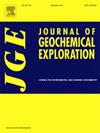澳大利亚碳酸盐岩及其伴生REE-Nb矿化研究综述
IF 3.3
2区 地球科学
Q1 GEOCHEMISTRY & GEOPHYSICS
引用次数: 0
摘要
澳大利亚有16个已知的碳酸盐岩,另外两个稀土矿化被解释为与碳酸盐岩有关。这些地区均位于前寒武纪地壳内,稀土氧化物(Nd2O3和Pr6O11)已知资源量约7.2 mt, Nb2O5已知资源量约2.7 mt。澳大利亚的碳酸盐岩范围从新太古代到侏罗纪,地质特征极其多样,既有以碳酸岩(如西澳大利亚的Gifford Creek和Mt. Weld)或硅酸盐岩(如西澳大利亚的Cummins range和Cundeelee)为主的大型多期侵入杂岩,也有单相小体积碳酸岩岩脉(如西澳大利亚的Yungal岩脉)。研究的矿床显示出同样多样化的放射性成因同位素特征(Rb/Sr和Sm/Nd),表明衍生自从HIMU到EM1的各种地幔源。在澳大利亚各地的新鲜和风化碳酸盐中都存在显著的稀土元素(REE)和铌(Nb)矿化,它们具有明显不同的矿物学和品位特征。虽然风化历史和保存对稀土和铌表生富集的形成至关重要,但对Mt. Weld和Gifford Creek杂岩不同类型碳酸盐岩的全岩地球化学数据分析表明,原生岩浆成分在品位增加幅度方面起着最重要的决定作用,以菱铁矿为主的碳酸盐岩的表生升级潜力小于以白云岩、铁白云岩和方解石为主的碳酸盐岩。澳大利亚已知碳酸盐岩的独特地球物理特征有助于勘探工作,导致在Mt. Weld和Cummins Range等高磁性复合体中早期发现矿床。最近发现的地球物理上微妙的复合体(例如,西Arunta的Gifford Creek复合体)表明,替代的地球物理技术和全面的结构理解对发现至关重要。勘探人员应该把重点放在已知的碳酸盐岩岩浆活动区域,特别要注意发展对可能促进碳酸盐岩侵入的区域结构的理解。在局部范围内,应优先考虑利用以前的局部发现选择相关的碳酸盐岩地球物理和勘探特征。与其他大陆的丰度相比,澳大利亚已知的碳酸盐岩数量较少,这表明随着勘探的增加,可能会发现更多的碳酸盐岩和相关的矿化作用。本文章由计算机程序翻译,如有差异,请以英文原文为准。
A review of Australian carbonatites and associated REE-Nb mineralisation
Australia has 16 known carbonatites, and two other occurrences of REE mineralisation interpreted as carbonatite-related. These are all located within Precambrian crust, and host known resources of c. 7.2 Mt. of rare earth oxides (containing c. 1.73 Mt. of Nd2O3 and Pr6O11), and c. 2.7 Mt. of Nb2O5.
Australia's carbonatites range from Neoarchean to Jurassic, and display extreme diversity in geological characteristics, ranging from large, multiphase intrusive complexes dominated by either carbonatite (e.g. Gifford Creek and Mt. Weld, Western Australia) or silicate rocks (e.g. Cummins Range and Cundeelee, Western Australia), to single phase and small volume carbonatite dykes (e.g. Yungal dykes, Western Australia). Studied occurrences show similarly diverse radiogenic isotopic signatures (Rb/Sr and Sm/Nd), indicating derivation from a variety of mantle sources ranging from HIMU through to EM1.
Significant rare earth element (REE) and niobium (Nb) mineralisation occurs in both fresh and weathered carbonatites throughout Australia, with markedly different mineralogical and grade characteristics. While weathering history and preservation are crucial to the formation of supergene enrichments in REE and Nb, analysis of whole-rock geochemical data for different carbonatite types from the Mt. Weld and Gifford Creek complexes suggest primary magmatic composition plays the strongest determinant in the magnitude of grade increase, with siderite-dominated carbonatites having less potential for supergene upgrade than dolomite, ankerite and calcite-dominated examples.
The distinct geophysical signatures of Australia's known carbonatites have aided exploration efforts leading to early discoveries of deposits within highly magnetic complexes such as Mt. Weld and Cummins Range. Recent discoveries of geophysically subtle complexes (e.g. Gifford Creek complex, West Arunta) suggests both alternative geophysical techniques and a comprehensive structural understanding are crucial to discovery.
Explorers should focus on areas of known carbonatite magmatism, with a particular focus on developing an understanding of the regional structures that can facilitate carbonatite intrusion. On a local scale, the selection of relevant carbonatite geophysical and exploration signatures leveraging previous local discoveries should be prioritised. The small number of known carbonatites in Australia compared to the other continents abundances indicates further carbonatites and associated mineralisation may be discovered with increased exploration.
求助全文
通过发布文献求助,成功后即可免费获取论文全文。
去求助
来源期刊

Journal of Geochemical Exploration
地学-地球化学与地球物理
CiteScore
7.40
自引率
7.70%
发文量
148
审稿时长
8.1 months
期刊介绍:
Journal of Geochemical Exploration is mostly dedicated to publication of original studies in exploration and environmental geochemistry and related topics.
Contributions considered of prevalent interest for the journal include researches based on the application of innovative methods to:
define the genesis and the evolution of mineral deposits including transfer of elements in large-scale mineralized areas.
analyze complex systems at the boundaries between bio-geochemistry, metal transport and mineral accumulation.
evaluate effects of historical mining activities on the surface environment.
trace pollutant sources and define their fate and transport models in the near-surface and surface environments involving solid, fluid and aerial matrices.
assess and quantify natural and technogenic radioactivity in the environment.
determine geochemical anomalies and set baseline reference values using compositional data analysis, multivariate statistics and geo-spatial analysis.
assess the impacts of anthropogenic contamination on ecosystems and human health at local and regional scale to prioritize and classify risks through deterministic and stochastic approaches.
Papers dedicated to the presentation of newly developed methods in analytical geochemistry to be applied in the field or in laboratory are also within the topics of interest for the journal.
 求助内容:
求助内容: 应助结果提醒方式:
应助结果提醒方式:


